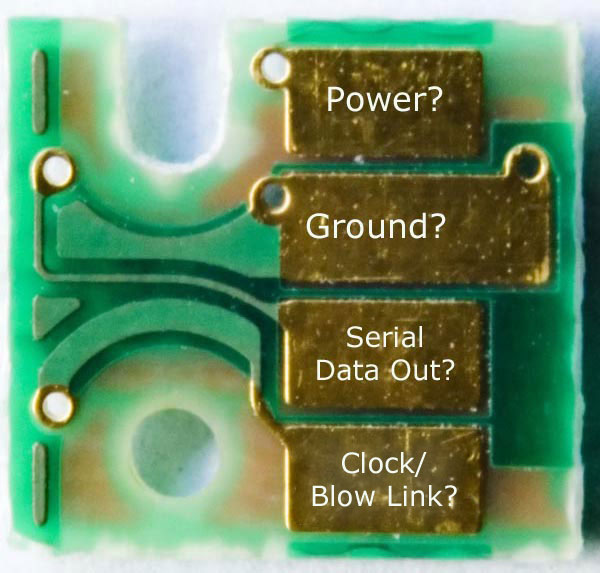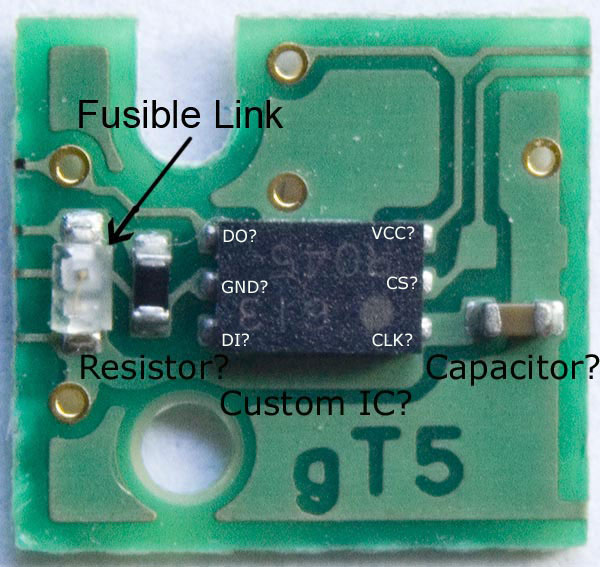canonfodder
Printer Guru
This may be a FNO message.
In the search for more understanding of Canon's chipped CLI-8 cartridges, I wonder if anyone has considered just how the ink information is really managed. Knowing the whole story could be very interesting.
It has been suggested that the count of ink jet commands is used to total up the amount that would indicate the ink level. This seems like a very reasonable assumption, but has anyone really checked this out. Does Canon suggest that, or do they say so directly in some publication?
The count of ink jet commands related to a specific cartridge would need to be stored in the chip.
Well, ..........not necessarily.
The ink level appears to be related to the specific, individual, cartridge. That being true means that the chip has a unique identity. A part of its identity is the ink color information to enable the 'wrong cartridge' function. Another part is EITHER a sort of serial number OR the ink level. A serial number could be set at the factory, even back at the wafer fab. Consider what a serial number can be used for. If the printer takes in the serial number, it can then total up the quantity of ink jets commanded for that chip/cartridge, keeping track of the information within the printer. This could mean that the chip does not have to be able to store this information. It would be required for the printer to have some non-volatile memory to keep the information. For the chip to be able to do its own record keeping, it would have to include some non-volatile memory.
There is a possible way to learn whether the chip really carries the ink level information or not. If a cartridge which indicates partly full were moved to a different printer, what would the ink monitor report? If it reports the correct partly full, then the chip must know the ink level. If the second printer thinks the cartridge is full, then it could be because the second printer has not seen that cartridge before, and assumes it is new and full.
Presently I am betting that the chip does keep count, meaning it has a non-volatile memory, but it would be very enlightening to learn that it does not. New avenues to deal with the chip would be opened.
Who on the forum could try this out for us? Move a partially full genuine Canon CLI-8 to another compatible printer and check the ink monitor's report.
Any volunteers ?
In the search for more understanding of Canon's chipped CLI-8 cartridges, I wonder if anyone has considered just how the ink information is really managed. Knowing the whole story could be very interesting.
It has been suggested that the count of ink jet commands is used to total up the amount that would indicate the ink level. This seems like a very reasonable assumption, but has anyone really checked this out. Does Canon suggest that, or do they say so directly in some publication?
The count of ink jet commands related to a specific cartridge would need to be stored in the chip.
Well, ..........not necessarily.
The ink level appears to be related to the specific, individual, cartridge. That being true means that the chip has a unique identity. A part of its identity is the ink color information to enable the 'wrong cartridge' function. Another part is EITHER a sort of serial number OR the ink level. A serial number could be set at the factory, even back at the wafer fab. Consider what a serial number can be used for. If the printer takes in the serial number, it can then total up the quantity of ink jets commanded for that chip/cartridge, keeping track of the information within the printer. This could mean that the chip does not have to be able to store this information. It would be required for the printer to have some non-volatile memory to keep the information. For the chip to be able to do its own record keeping, it would have to include some non-volatile memory.
There is a possible way to learn whether the chip really carries the ink level information or not. If a cartridge which indicates partly full were moved to a different printer, what would the ink monitor report? If it reports the correct partly full, then the chip must know the ink level. If the second printer thinks the cartridge is full, then it could be because the second printer has not seen that cartridge before, and assumes it is new and full.
Presently I am betting that the chip does keep count, meaning it has a non-volatile memory, but it would be very enlightening to learn that it does not. New avenues to deal with the chip would be opened.
Who on the forum could try this out for us? Move a partially full genuine Canon CLI-8 to another compatible printer and check the ink monitor's report.
Any volunteers ?


